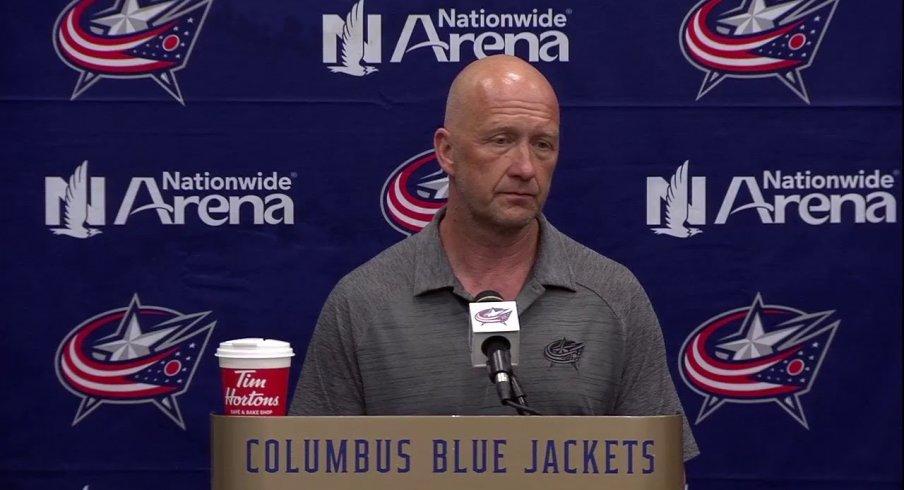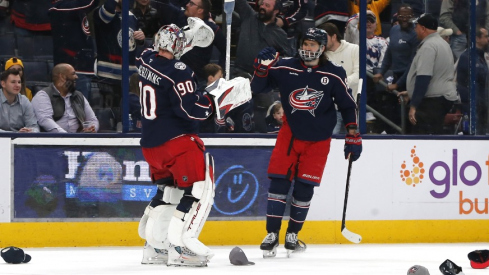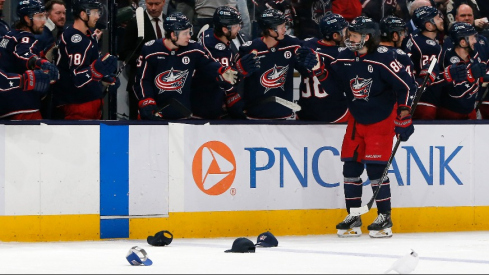John Tortorella’s season wrapped up a couple of weeks ago, but Jarmo Kekalainen’s season has only just begun.
The Columbus Blue Jackets general manager has started conducting business as his team entered its offseason following a first-round playoff loss to the Tampa Bay Lightning. He has talked to the media a couple of times following the postseason, including most recently on CBJ Radio’s The Inside Edge.
Typically, we look at Three Things to focus on in this space. But because of Kekalainen’s interesting comments on the show, we’re adding a couple of topics in order to hit on five different items.
A seven-year plan
So much of the conversation in the NHL – and, basically, every other major sports league – centers on what’s happening right now and what’ll happen in the immediate future. Not too many people are overly concerned with the happenings four or five years down the line.
Kekalainen doesn’t have that luxury. He and the front office regularly look well over a decade into the future in order to plan out where the Blue Jackets are heading.
“I think we go as far as a seven-year projection, and that's not only a player-evaluation thing,” Kekalainen said. “That's also cap projections and budget projections, so we have to evaluate the players that are already in the NHL and where they're going to trend in the NHL and what we're facing as far as their future contracts and how that's going to fit into the cap system.”
Part of the need to look so far ahead, Kekalainen said, is the slow process it often takes before draft picks make impacts in the NHL.
“I've always said that if you draft a player, even in the first round, sometimes it takes five to even eight years for them to make an impact in the NHL,” Kekalainen said. “They could make it to the NHL earlier. You draft a player in the later rounds. Usually, it’s two years in junior or in Europe or college, maybe even three or four years in college, then they come and make it to the pros and play a couple years in the American League, make it to the NHL and it takes a year before they can make an impact. So you put all those years together, sometimes you just have to be real patient with players before they reach their potential.”
Other teams that make more free-agent signings or are more prolific on the trade market might find it a bit more difficult to project so far out. But Columbus’ desire to build from within allows the franchise to have a better understanding of what’s to come in future seasons. Hypothetically, not as many players will be coming and going.
Still, of course, there’s plenty of talk about the present.
“We look at now. We look at next year and two, three years from now,” Kekalainen said. “Obviously you have to know the pending UFA, when they're going to be UFAs, when the contracts are expiring and how you build to fill potential holes in those situations.”
In The Middle
Columbus’ search for quality play from its centers has been well-documented. Dubois’ ever-improving play, however, gives the Blue Jackets someone they can feel comfortable with in the middle of the ice.
“We definitely believe that Pierre-Luc can play center,” Kekalainen said. “That was the plan all along that we drafted him and he can play center. He did play center six months in his last season in junior, but he hadn't played a lot of center. But we believed he could play center, and he's become a very good centerman and I think he's only going to get better.”
Outside of Dubois, Kekalainen sees two others just getting started on their NHL careers who could be of assistance: Texier and Foudy. But this season, both of them played largely on the wing.
Eventually, they could get shots at center, Kekalainen said.
“We had the same thought process with Texier. We had the same thought process with Liam Foudy, too,” Kekalainen said. “I think those two guys can also at some point be tried at center. It's a tall task to play center in the National Hockey League, not just on the offensive side but especially on the defensive side of play where you have to battle down low against the big centers of the other teams and sometimes that's where the coaches don't trust the young centermen, in particular, and they start at wing because of the defensive duties. But I think there's definitely potential in Texier and Liam Foudy to play at center as well.”
Free Agency Talk
Unrestricted free agency will be a breeze for the Blue Jackets this year. They’re not losing anybody off of their main roster, and Kekalainen has an aversion to building through those signings. It would be a surprise if Columbus gets heavily involved with unrestricted free agents.
Its restricted free agents, however, could produce some more interesting storylines.
Both Dubois and Vladislav Gavrikov are entering restricted free agency, and both, of course, will be brought back. Dubois, a 22-year-old former No. 3 overall pick, led Columbus with 10 points in the offseason. As an NHL rookie, Gavrikov secured a spot among the Blue Jackets’ top four defensemen.
“(Re-signing Dubois is) definitely a priority, like it is with all our core guys that are up with their contracts,” Kekalainen said. “Gavrikov's up as a restricted free agent, as well, and he was an important part of our defense this year. So we're going to take it one at a time and take it very seriously. As I always say, I'm 100 percent sure we'll arrive at a contract with both of them and they'll be on our team.”
It’s clear Anderson’s restricted free agency is a bit hairier of a situation. He’s been floated recently in trade rumors, and Kekalainen didn’t sound completely confident he’ll bring back the 26-year-old who missed the majority of the 2019-20 season with a shoulder injury.
“Josh has been a big part of our success and a great player for us, and he's in a little bit different of a situation because he's an RFA with arbitration rights, but he's only one year away from being an unrestricted free agent,” Kekalainen said. “We either agree on a contract or then we have to make our decisions.”
Across The Ocean
Ears perked up when Kekalainen initially floated the idea two weeks ago of players on Columbus’ roster going to Europe for the next couple of months. He wants certain Blue Jackets to avoid spending nine or so months out of game action.
As it turns out, while he’s had discussions with players about the possibility of playing in European leagues, it’s been a challenge to find open spots.
“Now, it's getting pretty crowded in Europe where a lot of teams are taking back the guys that are from there,” Kekalainen said. “That's an automatic for a lot of teams. 'OK, you played here before. Of course, welcome back.' Then you're trying to place other guys there in good situations where they'd get an opportunity to play a good role and develop under a good coach and with a good team. It's not as easy as it is if you have one or two guys now that it's getting flooded with guys that have North American experience.”
No Movement, No Problem?
Every year, the NHL’s salary cap slowly increases. That’s the nature of the sport.
Or, that was the nature of the sport.
In July, the league announced that the salary cap will remain the same – $81.5 million – in the 2020-21 season, meaning it won’t take the expected leap of $3 million-$7 million. The flat cap is not expected to steadily increase in the following years, either.
“I don't know if it makes it easier because everybody was projecting the cup to go up every year, but it's not going to do that,” Kekalainen said. “We'll be fine. We'll have to potentially make some hard decisions, but that's what we get paid for. Yeah, we know where it is, but there are some teams that are going to get squeezed a little bit. There could be an opportunity there. But first, we have to take care of our own business and make sure that we don't put ourselves in a vulnerable position and just keep building forward.”


